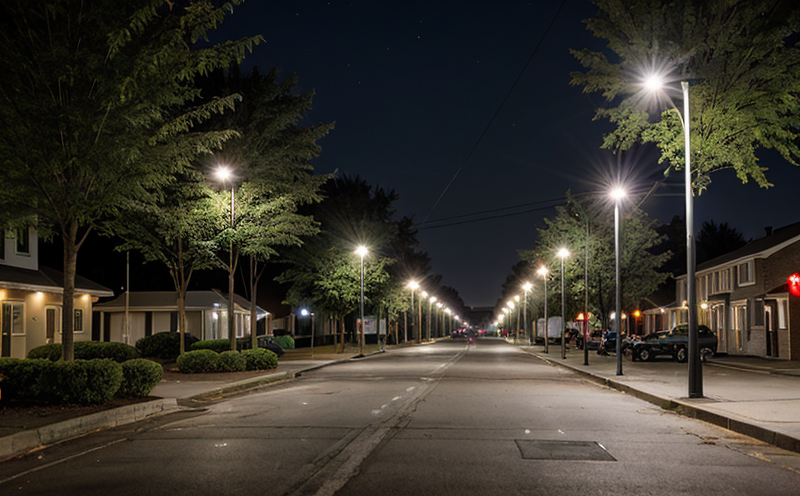CIE 232 Outdoor Lighting Stroboscopic Testing of Road Systems
The CIE 232 standard is a critical tool used in the evaluation and certification of outdoor lighting systems, particularly those intended for road environments. This testing ensures that streetlights and other outdoor luminaires meet stringent performance criteria to enhance safety and visibility under stroboscopic effects—conditions where light intensity changes rapidly over time.
The stroboscopic effect can occur in various situations such as when vehicles pass by or when the lights are near sources of flickering light like electrical substations. Understanding how lighting behaves during these conditions is crucial for ensuring that drivers and pedestrians have a safe experience, especially at night. The CIE 232 standard provides a method to assess this behavior accurately.
The testing process involves simulating real-world conditions where the stroboscopic effect can be observed. This includes placing the lighting fixture under controlled test conditions that mimic the environment in which it will be used. During these tests, the luminaires are exposed to rapid changes in light intensity, and their performance is monitored for flicker, color distortion, and other relevant parameters.
The testing apparatus typically consists of a stroboscope or similar equipment capable of generating controlled variations in light intensity. The fixtures are then evaluated based on specific criteria outlined in the CIE 232 standard. These criteria include but are not limited to flicker frequency, luminous flux stability, and color appearance changes.
Compliance with this standard is essential for manufacturers to ensure their products meet international quality standards and are suitable for use in diverse lighting environments. This testing process helps identify any potential issues early on, allowing for necessary adjustments before the products reach the market. The results of these tests provide valuable data that can be used by designers and engineers to improve future iterations of outdoor lighting fixtures.
In summary, CIE 232 stroboscopic testing is vital in ensuring that streetlights and other outdoor luminaires perform reliably under conditions where rapid changes in light intensity occur. By adhering to this standard, manufacturers can guarantee their products meet the necessary requirements for safety and visibility, thereby enhancing overall road safety.
Industry Applications
- Testing of streetlights and other outdoor luminaires
- Evaluation of lighting systems in complex environments with rapid changes in light intensity
- Ensuring compliance with international standards for road safety
| Application | Description |
|---|---|
| Urban Roadways | Evaluation of lighting systems on busy urban roads to ensure adequate visibility and safety. |
| Night-Time Driving Conditions | Testing the performance of luminaires under conditions where rapid changes in light intensity are expected, such as near traffic signals or power substations. |
| Pedestrian Safety Zones | Evaluation of lighting systems around pedestrian crossings and other high-traffic areas to enhance visibility during low-light conditions. |
| Tunnel Entrances/Exits | Testing the performance of luminaires at tunnel entrances and exits, where rapid changes in light intensity can occur due to varying external lighting conditions. |
We Offer Expertise in CIE 232 Testing
Eurolab is committed to providing comprehensive testing solutions for the lighting industry, and our expertise in CIE 232 testing sets us apart. With state-of-the-art facilities and experienced technical staff, we ensure that every test conducted adheres strictly to international standards.
Our laboratory offers several advantages when it comes to conducting CIE 232 stroboscopic testing:
- Precision Instruments: We use high-precision instruments specifically designed for this type of testing, ensuring accurate and reliable results.
- Compliance with Standards: Our tests are conducted in full compliance with the latest versions of CIE 232 standards, providing you with confidence that your products meet all necessary requirements.
- Experienced Staff: Our team comprises highly skilled professionals who have extensive experience in lighting testing and stroboscopic effects.
- Comprehensive Reporting: We provide detailed reports outlining the results of each test, including any areas where improvements can be made. This information is invaluable for ongoing product development and quality assurance.
By choosing Eurolab for your CIE 232 testing needs, you can rest assured that your products will meet the highest standards of performance and reliability, ensuring they are safe and effective in all intended environments.
Ensuring Quality and Reliability in Lighting Systems
The importance of quality and reliability in lighting systems cannot be overstated. In the context of CIE 232 testing, ensuring that outdoor luminaires perform consistently under stroboscopic conditions is paramount for maintaining public safety and enhancing visibility.
At Eurolab, we take a proactive approach to quality assurance by implementing rigorous testing protocols based on international standards such as CIE 232. Our facilities are equipped with advanced technology and experienced personnel who understand the nuances of lighting behavior under rapid changes in light intensity.
The process begins with meticulous preparation of each specimen for testing, ensuring that it accurately represents the product to be evaluated. Once prepared, the fixtures undergo a series of tests designed to simulate real-world conditions where stroboscopic effects are likely to occur. These tests include measurements of flicker frequency, luminous flux stability, and color appearance changes.
After completing these tests, our team analyzes the data collected from each specimen. Any deviations from expected performance levels are noted and addressed immediately. This ongoing process ensures that all tested products consistently meet or exceed established standards for reliability and safety.
The results of these tests serve multiple purposes. They provide valuable insights into potential improvements needed for future iterations of lighting fixtures, they help identify any issues present in current models early on, and most importantly, they ensure compliance with relevant international standards like CIE 232. By adhering to these standards, manufacturers can confidently introduce products that are known to perform reliably even under challenging stroboscopic conditions.
In conclusion, at Eurolab, we pride ourselves on delivering exceptional quality and reliability assurance services for lighting systems through our commitment to precision testing based on international best practices like CIE 232. Our goal is not only to meet but exceed customer expectations by providing thorough evaluations that reflect real-world performance conditions.





